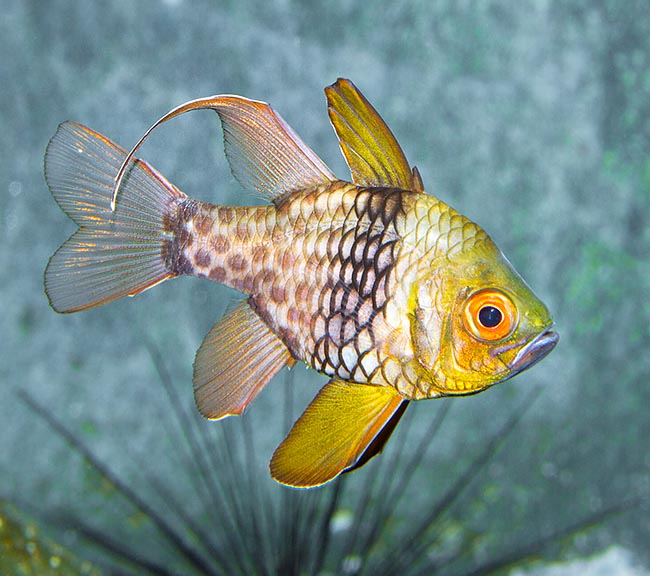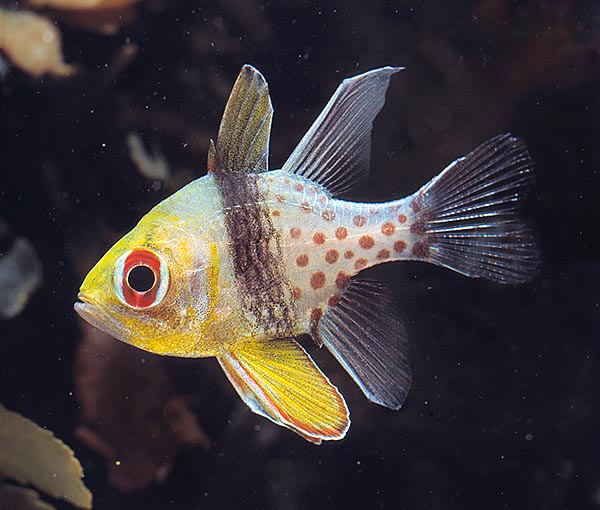Family : Apogonidae

Text © Giuseppe Mazza

English translation by Mario Beltramini

Sphaeramia nematoptera adult with the typical extension of the second dorsal fin © Giuseppe Mazza
The etymology of the genus “sphaeramia” comes from the Greek “sfaira” = sphere, due to the roundish look of the animal and from “amia” the term used by the old Greeks for indicating a shark, due to the great first dorsal fin, which recalls these sea raiders.
The name of the genus may also come from the old genus Amia, erroneously used until the middle of the 20th century for the “cardinalfishes”. It would be then a “round Amia “.
The name of the species “nematoptera” comes always from the Greek “nema, -atos” = thread and “pteron” = wing, fin, with reference to the second dorsal fin which in the adults has a long filament.
Zoogeography
It lives in the tropical waters of the Western Pacific; approximately from Indonesia, New Guinea and the Australian Great Barrier Reef up to New Caledonia, the Fiji Islands and Tonga. Northwards, it has colonized the Micronesia, the Philippines and the southern part of Japan.
Ecologia-Habitat
It is an animal for still waters, rich of ramified madrepores, such as those of the genus Acropora, with a bias for the Porites nigrescens and the Porites cylindrica, where it spends, hidden, great part of the day. It rarely descends more than 15 m and the juveniles usually grow up among the roots of the mangroves.

The livery is splendid and the big eye allows a perfect night vision © Giuseppe Mazza
It is a truly unique fish. The flat, oval, body may reach the 9 cm, including the great caudal fin, but in the whole the look is roundish, as suggests the name of the genus.
On the back stand out two fins. The first, triangular like that of a shark, has 6-7 spiny rays. The second has 1 spiny ray and 9 soft rays with a long filament, cranked almost as broken. The anal fin has 2 spiny rays and 9-10 soft, the pectoral ones, transparent, with 12-14 lobes, is translucent, slightly pinkish, like the second dorsal and the anal. Also the great ventral fins are characteristic: two golden blades with red small border edged of white.
Also the fore part of the body is golden, with an enormous eye, for a good night vision, and the iris is red-orange with two clear bands. At the height of the first dorsal fin the sides are crossed by a dark zone, the “pajamas belt” which follows, white dotted, as they used time ago.
The mouth is huge in comparison with the body. It opens downwards for swallowing copepods, small worms and small benthic crustaceans.
Ethology-Reproductive Biology
During the day the pajama cardinalfish lives hidden among the madrepores in small schools and gets out only by the sunset looking for food.
At the time of the reproduction, pairs take form. The fecundation is external, but then the male collects the mass of eggs and keeps them in its mouth for about ten days, without eating, till the hatching. At their birth, the larvae measure only 3 mm and in aquarium, where the Sphaeramia nematoptera has reproduced several times, this small species may live even 8 years.
Thanks to the paternal cares, the populations are able to double their members in less than 15 months and the vulnerability index is consequently very low: just 10 on a scale of 100.
Synonyms
Apogon nematopterus Bleeker, 1856.
→ For general information about FISH please click here.
→ For general information about BONY FISH please click here
→ For general information about CARTILAGINOUS FISH please click here.
→ To appreciate the BIODIVERSITY of BONY FISH please click here.
→ To appreciate the BIODIVERSITY of CARTILAGINOUS FISH please click here.
